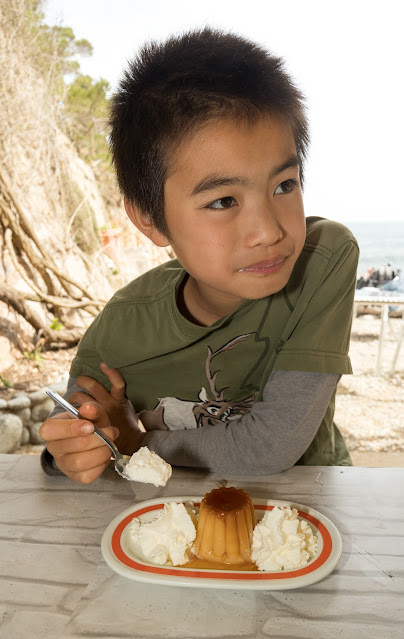The hotel breakfast was scrumptious, filling, and generous, and the kids were finally done with jet lag, sleeping until 7:30am. After breakfast, we packed everything into the car, moved it into the requested hotel parking space, and then went to exchange our electronic coupon for tickets at the House Museum. The house museum opened at 10:00am, but if you were there early, they'd let you in 10 minutes early. They let you in in batches, so as to not crowd the space, and masks are required indoors.

I'm not usually a big fan of museums, since for paintings, etc., I rarely feel the need to see the original artwork, and virtual tours instituted since the pandemic seem to be pretty good. But Dali's house was an exception, left the way he had it was an artist's working studio and home, and the level of detail was really cool to see, such as the mirror that enabled him to claim to be the first man in Spain to see the sunrise from his bed, the hoist and rig that enabled him to paint huge canvases while sitting down, and even the gardens and grounds.
The outside laundry drying area was interesting, with view cutouts into the wall that provided glimpses of the sea. Even his swimming pool was unusual and different, decorated with a combination of the artist's taste and child's whimsy. It was definitely worth a visit, with us watching the video documentaries in the outdoor viewing area for far longer than I would have expected.
After the museum, I decided we had time to go visit Cap De Creus, the place we had attempted to hike to the day before. I noted from a display in the hotel that while it was forbidden to drive there during the summer months, it was perfectly fine to do so now, so we drove the scenic, rugged road to the lighthouse, making a note to myself that it would have made a perfectly nice bike ride. Once there, we took a hike, exploring the coast. It had been forecasted to rain, but it was doing so in a very vague way.


Boen started complaining about the amount of walking required, claiming that the museum tour qualified for exercise. We finished the hiking by 1:00pm, but no one was hungry, so I decided to show everyone Llanca on our way to Girona. The drive was as exciting as the bike ride had been 3 years ago, but I don't know if Xiaoqin saw much of it as she fell asleep in the car. Bowen thought the coast view was impressive, however, and Xiaoqin woke up as we got to Llanca in time to find us a restaurant.
Restaurant Miramar turned out to be a 2 star Michelin restaurant that uncharacteristically had room for us at lunch! The menu was crazy expensive, but heck, it was raining and we had no place to go in a hurry, so we signed up for the experience. Bowen was very impressed by the choreography, and the initial opening dishes where they told him what order to eat what in, but was unimpressed by the entree. I myself have never been impressed as far as how good the food tasted by any Michelin restaurants I'd ever been to with the exception of Funky Gourmet, which unfortunately was a victim of COVID19. For my money, Kebab & Curry in Santa Clara probably has better food than any of the 1 or 2 star Michelin restaurants in the Bay Area. (Kebab & Curry was so good that Michelin had create a special no-star category for it and other restaurants like it) I explained to Bowen that Rosenlaui and that magical day in Les Rauffes in France with Mike Samuel were excellent culinary experiences, but were inaccessible to most people. Xiaoqin, of course, begged to differ and accused me of brain-washing my kids into thinking that cycling was far better than eating.

After lunch, we drove to Girona, where I was led down a street blockaded for construction in order to pick up my keys for the AirBnB I'd rented. The rental management company gave me incredibly complex directions for getting into the apartment. I'd recalled that old town roads were blockaded by
bollards so car drivers couldn't drive into old town Girona. It turned out that those bollards were controlled by a remote control that owners of those apartments had and could be lowered. You then had to drive around 5mph until you got to the garage and then drop your car (in a leap of faith) down a steep grade into the basement parking. It was terrifying doing this in a stick shift, but you know what, a Dad who agreed to take his kids up the Stelvio this summer cannot be faint of heart, so I did it without a hint to my kids that this was difficult.
We then walked around town and went to Volver first for Empanadas and then to El Carrito Barri for steak. We bought yogurt and other sundries at the local supermarket. The total price was less than 10% of what we paid for Miramar but was pretty satisfying. We went to bed at a reasonable hour and anticipated the Food Tour I had organized the next morning.









































